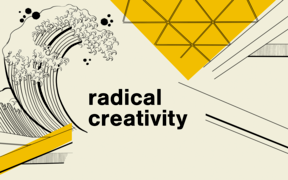Radical creativity empowers new thinking

I assume no-one needs to be reminded that big, profound changes can happen fast, as this year has proven. Those organisations, teams and individuals that are prepared for not only responding to fast changes but also regenerating their purpose on a longer-term are the ones who thrive.
I’ve researched the future of work, and that’s why this age of massive disruption is particularly intriguing to me.
The better we understand future work life and societal needs, the better we as a university can educate game changers and do research on societal renewal and the wellbeing of our individuals, society and the entire planet – and all with a high positive impact.
While in theory, it’s quite straightforward to explain how to manage creative organisations (you can’t), you can still manage better settings for creativity.
In reality, it’s a complex issue, because it deals with organisational culture and mindset, the courage to experiment, and a feeling of trust and meaningfulness. These relate to our emotions and values and cannot be measured and managed like traditional performance indicators.
Tensions are always present in organisations; the paradox theory suggests solutions will have to be “both-and”, to recognise both sides of the tension. Contingency-theory- driven “either-or” approaches focus on one “optimal solution” which often result in hierarchic structures. In today’s world, repetitious processes can become obsolete fast.
Continuous regeneration of organisations requires networked creativity, an ability to create value in novel ways and often even without pre-set rules and roles. Artists, designers and start-up entrepreneurs have worked like this: project by project, combining unexpected things, experimenting with alternatives instead of linear processes and career paths.

So, how do we find the right balance in the trade-off between building structures for efficient workflows and sandboxes for more radical experimentation and renewal outside the existing processes?
We want to be an outstanding community for new thinking and doing, and that requires fostering a culture that tolerates diversity and failure – building capabilities to deal with constant uncertainty – while also being enjoyable.
Collaborating with people from different backgrounds enables us to see phenomena through various perspectives, and elaborate ideas through diverse means. Hands-on experimentation, drawing, modelling, illustrating, visualising, prototyping or documenting can open up new thinking and improve dialogue, therefore building the basis for something radically new.
Aalto aims to take an internationally leading position concerning radical creativity and its leadership. We believe this mindset and competence will help individuals, teams and organisations not only navigate but also positively stimulate the changes of tomorrow.
Dennis Gabor, the physicist, who won the Nobel Prize for inventing holography, wrote in 1963: ‘The future cannot be predicted, but futures can be invented.’
What kind of future would you be excited to invent and be a part of?
Kristiina Mäkelä
Provost
Unfolded
Aalto University UNFOLDED magazine focuses on contemporary issues dealing with creativity, experimentation, and transdisciplinary co-creation.

Radical creativity
We enable experimental activities that challenge the status quo.

- Published:
- Updated:
Read more news

Aalto in 2024: Love pictured in the brain, wooden crystals that make fashion shine, recovering minerals from wastewater and more
This year has been another feast of science and art at Aalto University
The City of Espoo and Aalto University signed a strategic agreement for a new five-year partnership period
The collaboration includes investments in the Otaniemi area, business and innovation activities, and efforts to integrate international talent.